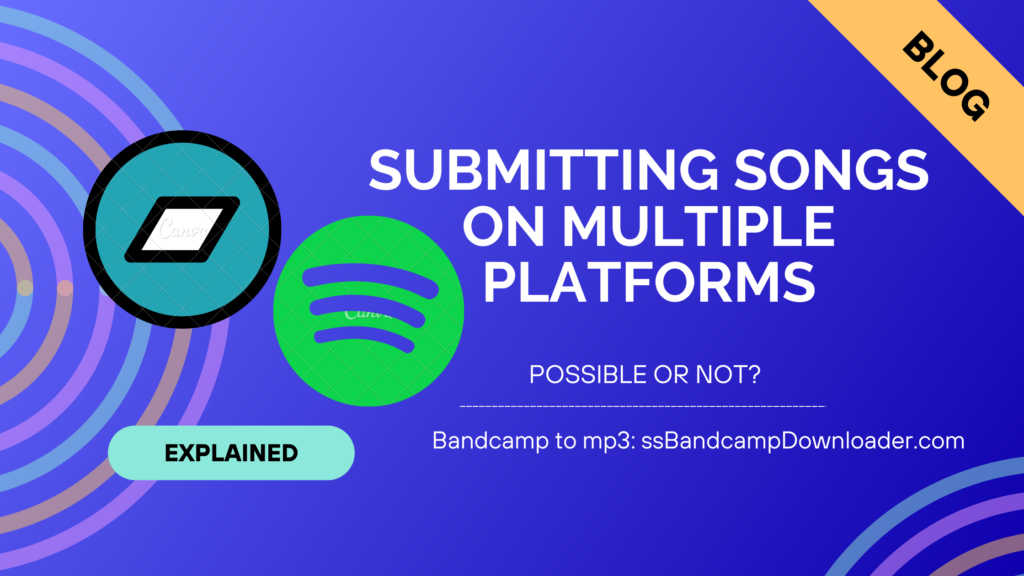The world of music streaming and distribution has evolved dramatically in recent years. Platforms like Bandcamp and Spotify at the forefront of this digital revolution. In this article, we will delve into a concise comparison of Bandcamp and Spotify, two influential players in the music industry.
While both offer access to an extensive library of music, they cater to distinct audiences and come with unique features and advantages. This exploration aims to help music enthusiasts, artists, and consumers alike make informed choices regarding their preferred music platform, shedding light on the strengths and limitations of each service.

Bandcamp vs Spotify Compared
| Feature | Bandcamp | Spotify |
|---|---|---|
| Music Catalog | Focuses on independent and emerging artists, allowing them to sell and stream their music. Offers a wide range of genres, including niche and underground music. | Offers an extensive catalog of mainstream music, including popular artists, labels, and an enormous library of songs and albums. |
| Streaming Subscription | Bandcamp offers a subscription service called “Bandcamp Plus” that includes unlimited streaming, offline listening, and exclusive releases. | Spotify offers both free and premium subscription options, with premium offering features like offline listening, no ads, and unlimited skips. |
| Free Tier | Bandcamp allows artists to offer free streaming of their music, but it may not be available for all songs. | Spotify has a free tier with ads, allowing users to listen to music for free, but with limitations like shuffle play and ads. |
| Purchasing Music | Allows users to purchase music, albums, and merchandise directly from artists and labels. | Primarily a streaming platform and does not offer direct music purchasing, although users can create playlists and add local files. |
| Offline Listening | Bandcamp Plus subscribers can download music for offline listening. | Spotify Premium subscribers can download songs and playlists for offline listening. |
| Integration with Ecosystems | Limited integration with other streaming platforms and devices. | Offers extensive integration with various devices, platforms, and services, including mobile, desktop, and smart speakers. |
| Music Discovery | Offers various tools for music discovery, including tags, genres, and user-generated lists. | Provides personalized playlists like Discover Weekly and Release Radar, as well as algorithm-driven recommendations. |
| Exclusive Content | Features exclusive releases and early access to music from independent artists. | Occasionally offers exclusive content, such as artist exclusives, podcasts, and original content. |
| User-Generated Content | Allows artists to create and share their playlists and content, which users can follow. | Users can create and share playlists, follow friends’ playlists, and collaborate on playlists with others. |
| Advertisements | Typically ad-free for listening, although some artists may include promotional content. | Free tier includes ads, which can be removed with a Premium subscription. |
| Pricing | Bandcamp Plus: $10/month (unlimited streaming, offline listening) | Spotify Premium: Starts at $9.99/month (ad-free, offline listening), with various plans, including Family and Student options. |
| Availability | Available worldwide but may have limited availability in some regions. | Available in numerous countries with a broader international presence. |
| Platforms | Accessible through web browsers and dedicated apps for Android and iOS. | Compatible with web browsers, dedicated apps for various platforms, and support for many smart speakers and devices. |
Music Discovery and Catalog
When it comes to music discovery and catalog diversity, Bandcamp and Spotify take contrasting approaches, catering to different tastes and needs.
Bandcamp is a haven for independent artists and labels. It’s a place where lesser-known musicians and niche genres thrive. If you’re into exploring the underground music scene or want to support emerging artists, Bandcamp’s catalog is a treasure trove.
It’s a platform where artists have more control over their content, making it an excellent choice for eclectic tastes and those who prefer to support the artists directly.
On the other hand, Spotify shines in offering a vast catalog of mainstream and popular music. It’s your go-to platform for chart-toppers, latest hits, and established artists.
If you’re inclined towards discovering what’s trending in the music world or want access to a vast library of well-known tracks, Spotify’s extensive collection won’t disappoint. Additionally, Spotify’s personalized playlists and algorithms help users discover new music based on their listening habits. This makes it a valuable tool for music exploration.
In summary, your choice between Bandcamp and Spotify for music discovery and catalog largely depends on your musical preferences. Bandcamp offers a diverse range of music, especially for those seeking indie and underground sounds, while Spotify caters to a broader audience with its extensive mainstream catalog and personalized recommendations.
Artist-Friendly Features
Bandcamp and Spotify offer distinct sets of artist-friendly features, each appealing to different aspects of an artist’s career and goals.
Bandcamp is renowned for giving artists significant control and ownership of their music. Musicians can set their own prices for their music, merchandise, and even offer free downloads if they choose.
This level of autonomy is especially attractive to independent artists and labels who want to maintain creative and financial control over their work. Furthermore, Bandcamp’s revenue-sharing model ensures that artists receive a substantial percentage of each sale, making it a platform where artists can directly benefit from their fan base’s support.

Spotify, while primarily a streaming platform, has introduced various promotional tools and features to support artists. Spotify for Artists allows musicians to access valuable fan analytics, understand their audience, and refine their marketing strategies.
Additionally, Spotify offers playlist placement opportunities, which can significantly boost an artist’s visibility and reach. However, it’s important to note that the primary revenue model for artists on Spotify comes from streaming, which may not be as financially rewarding as direct sales, especially for smaller, independent acts.
In conclusion, the choice between Bandcamp and Spotify’s artist-friendly features depends on an artist’s goals and preferences. Bandcamp empowers artists with direct control and revenue, while Spotify offers tools for exposure and audience insights, but its primary revenue stream is streaming, which may not be as lucrative for all artists, particularly those in niche or emerging genres.
Pricing and Subscription Models
Bandcamp and Spotify have distinct pricing and subscription models that cater to different consumer preferences and financial considerations.
Bandcamp primarily operates on an à la carte model. Users can purchase individual songs or albums at prices set by the artists. There is a free tier for streaming on Bandcamp. Also, It’s a platform designed to support artists through direct purchases.
This model appeals to music enthusiasts who want to support their favorite artists by buying their music and merchandise directly. It also allows artists to have control over their pricing, which can be advantageous for independent musicians.

Spotify, in contrast, offers a tiered pricing structure. It has both a free tier with ads and a premium paid tier. Spotify Premium users enjoy benefits like ad-free listening, offline downloads, and higher audio quality.
Additionally, Spotify offers student and family plans, making it an attractive option for households and students looking to share a subscription. This model is ideal for users who want a seamless and affordable way to access a vast music library but don’t necessarily prioritize direct artist support.
The choice between Bandcamp and Spotify’s pricing models depends on your preferences as a music consumer. If you value direct support for artists and are willing to pay for music individually, Bandcamp is a great choice. On the other hand, if you prefer a more budget-friendly option with access to a broad range of music and added features like offline listening, Spotify’s tiered pricing may be more appealing.
Audio Quality
When it comes to audio quality, both Bandcamp and Spotify offer different options that cater to varying listener preferences.
Bandcamp is known for its commitment to providing high-quality audio. One of its standout features is the ability to offer users the option to download music in various formats, including lossless audio formats like FLAC.
This is a significant advantage for audiophiles who prioritize pristine sound quality and want to enjoy their music in the highest fidelity possible. Bandcamp’s dedication to maintaining audio integrity makes it a top choice for those who value exceptional sound reproduction.
Spotify provides streaming at various quality levels to accommodate different network conditions and device capabilities. While Spotify does offer high-quality streaming, it relies on audio compression techniques, which may not satisfy the discerning ears of audiophiles.
The platform uses the Ogg Vorbis format for its highest quality streaming, which, while generally good for most listeners, may not be on par with lossless audio formats like those offered on Bandcamp.
In summary, if audio quality is of paramount importance to you, and you have the necessary storage space and playback equipment, Bandcamp’s support for lossless audio formats makes it the superior choice. On the other hand, if you prioritize convenience and a wide selection of music over absolute audio fidelity, Spotify is a more practical option.
Offline Listening and Device Compatibility
Both Bandcamp and Spotify offer solutions for offline listening and are compatible with a range of devices, but they have different approaches to these aspects.
Bandcamp primarily focuses on downloads, making it straightforward for users to enjoy music offline. When you purchase music on Bandcamp, you often have the option to download it in various formats, which you can then transfer to your preferred devices.
This approach is advantageous for users who want complete control over their offline music library and the ability to enjoy it without an internet connection. However, it requires some effort in terms of managing files and storage space.

Spotify provides a more streamlined solution for offline listening through its Premium subscription tier. Premium users can download songs and playlists for offline playback within the Spotify app on mobile devices and computers.
This feature is user-friendly and doesn’t require manual file management, making it convenient for users who want a hassle-free offline listening experience. Spotify’s offline mode is especially beneficial for commuters and travelers who need music with limited internet access.
Regarding device compatibility, both platforms have dedicated apps for various operating systems, including iOS, Android, and desktop platforms. This ensures that you can access your music on a wide range of devices, from smartphones to tablets and computers.
If you value simplicity and convenience in offline listening, Spotify’s Premium subscription offers a hassle-free experience. However, if you prefer more control over your offline music library and don’t mind managing files, Bandcamp’s download options provide flexibility. Both platforms cater to a variety of devices, making it easy to enjoy your music wherever you go.
User Experience and Interface
The user experience and interface of Bandcamp and Spotify are designed with different priorities and aesthetics, catering to distinct user preferences.
Bandcamp places a strong emphasis on providing an artist-centric and community-driven experience. Its interface is as minimalistic and straightforward, putting the spotlight on the music and the artists. Users can easily navigate artist pages, read about their work, and discover related artists.
Bandcamp’s focus on community engagement is evident through features like fan messaging and artist recommendations. These elements create a sense of connection between artists and their audience.
Spotify, on the other hand, offers a user-friendly and highly polished interface. It is designed to prioritize ease of use and music discovery. Spotify’s homepage is populated with personalized playlists, recommendations, and popular tracks, making it effortless to find new music or revisit old favorites.
Its algorithm-driven playlists like “Discover Weekly” and “Release Radar” aim to introduce users to fresh music based on their listening history. The platform’s social features, such as collaborative playlists and artist followings, encourage users to share music with friends and stay updated on their favorite artists’ latest releases.
The choice between Bandcamp and Spotify’s user experience and interface depends on your preferences. If you value a straightforward and artist-focused platform that allows for deeper engagement with musicians, Bandcamp may be more appealing. Conversely, if you prefer a seamless, algorithm-driven experience that helps you discover new music effortlessly, Spotify’s user-friendly interface might be a better fit.
Regional Availability
Both Bandcamp and Spotify have different levels of regional availability. This can impact your choice depending on where you are located.
People know Bandcamp for its global accessibility. It’s available to users around the world, and artists from various countries can upload their music to the platform. This inclusivity makes Bandcamp an excellent choice for both artists and listeners who want to share and discover music from different regions and cultures. It ensures that independent artists from anywhere can reach a global audience.
Spotify offers a mix of global and region-specific availability. While Spotify has expanded its reach to many countries, it is still not accessible everywhere. The availability of content, including music and podcasts, can vary significantly depending on your geographical location.
For users in regions where Spotify is fully supported, it provides an extensive catalog of both local and international music. However, in areas where it’s not available or has limited content, users may find the platform less appealing.
Your choice between Bandcamp and Spotify in terms of regional availability should be influenced by your location and the specific content you want to access. If you’re in a region where Spotify is fully supported and offers a wide selection of music you enjoy, it can be a great choice. However, if you’re looking for a more universally accessible platform or want to explore music from various regions, Bandcamp’s global reach makes it a compelling option.
Licensing and Copyright Issues
When it comes to licensing and copyright, Bandcamp and Spotify have distinct approaches and potential issues that users should consider.
Bandcamp operates with a more artist-friendly approach to licensing and copyright. Independent artists and labels have greater control over their music, allowing them to set their own terms and pricing.
This means artists can choose to offer their music for free, set specific pricing, or even sell physical merchandise alongside digital downloads. Bandcamp’s model empowers artists to make decisions about their intellectual property without interference from major labels.
Spotify, being a streaming giant, operates under complex licensing agreements with major record labels and publishers. While this allows for a vast music library, it also means that artists signed with major labels often have their music featured prominently on the platform.
Smaller, independent artists may face challenges in negotiating favorable terms with record labels. The revenue they receive from streaming may be considerably lower than what they could earn through direct sales.
It’s important to note that issues related to licensing and copyright on Spotify may also lead to occasional removal of songs or albums due to disputes or renegotiations between the platform and rights holders. This can sometimes result in frustration for users who suddenly find their favorite tracks unavailable.
In summary, Bandcamp’s approach empowers artists with greater control over licensing and copyright, allowing for more flexibility and transparency. On the other hand, Spotify’s reliance on major labels can lead to licensing complexities and occasional content availability issues. Users should consider their support for independent artists and their stance on copyright when choosing between the two platforms.
Conclusion | Spotify vs Bandcamp
In conclusion, the choice between Bandcamp and Spotify ultimately depends on your specific needs and priorities in the realm of music consumption. Bandcamp stands as a champion of independent artists, offering direct artist support, diverse catalog options, and high-quality downloads.
It fosters a sense of community and artistic autonomy. In contrast, Spotify excels in convenience, with an extensive mainstream catalog, personalized playlists, and offline listening options.
However, it leans on major label partnerships, potentially affecting artist compensation and content availability. Whether you prioritize direct artist support and unique discoveries or seek convenience and a vast library, your choice between Bandcamp and Spotify should align with your musical values and preferences.
FAQs
Bandcamp offers free access for users to discover and stream music. However, artists have the option to sell their music, and users can choose to purchase albums or tracks directly. This purchase supports the artists, and the pricing is set by the artists themselves.
No, Spotify’s free plan does not include offline listening. Offline listening is a feature reserved for Spotify Premium subscribers. With a Premium subscription, users can download songs and playlists for offline playback.
Spotify operates differently from Bandcamp in this regard. While artists can upload their music to Spotify, it typically requires distribution through a third-party service or record label. Bandcamp, on the other hand, allows artists to directly upload and sell their music on the platform.
While Bandcamp is known for its support of independent artists and labels, it also hosts some mainstream and established musicians. However, its focus is on providing a platform for independent and emerging artists to showcase their work.
Yes, Spotify’s music catalog availability can vary by region due to licensing agreements. Some tracks or albums may not be accessible in certain countries or regions. Users may encounter regional restrictions that affect the availability of specific content on the platform.
